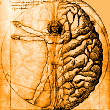Monday, 9 July 2012
Embodied Cognition and Emotions
 Expressions such as “receiving a warm welcome” and “giving someone the cold shoulder” seem to be rooted deep in our bodily experience, or at least, that is the conclusion increasingly suggested by studies on embodied cognition, a field first developed in the 1990s by researchers such as Francisco Varela.*
Expressions such as “receiving a warm welcome” and “giving someone the cold shoulder” seem to be rooted deep in our bodily experience, or at least, that is the conclusion increasingly suggested by studies on embodied cognition, a field first developed in the 1990s by researchers such as Francisco Varela.*
For example, studies show that if you have to read a brief description of someone whom you do not know, then assess their personality on that basis, you are more likely to describe them as friendly and likable if you are holding a cup of hot tea than if you are holding a glass of iced tea. Other studies have shown that if you are asked to recall a social situation in which you were involved, then estimate what the room temperature was at the time, you will cite a temperature about 5°C lower if it was a situation where you were socially rejected than if it was one where you were socially accepted.
And temperature is not the only physical variable that exerts this kind of influence on cognition. For example, if two sets of respondents are asked to complete a survey questionnaire consisting of multiple sheets in a binder, the respondents who are handed a physically heavier binder are likely to consider the survey topic more important—weightier, metaphorically speaking.
This feedback from the state of contraction of certain muscles to the brain greatly affects not only intellectual judgments, but emotions as well. For example, researchers have learned that when Botox is injected into certain muscles in the forehead in order to paralyze them and thereby reduce wrinkles, the resulting decrease in the ability to make certain facial expressions interferes with the ability to express certain emotions as well. But as has been discovered more recently, this muscular paralysis also slows the perception of emotions such as anger or sadness. The apparent reason is the disruption of the unconscious contraction of these forehead muscles that occurs naturally when someone experiences such negative emotions.
More and more research is being done in the field of embodied cognition, so we will certainly be talking about studies like these again in this blog, and in particular about the role played by a brain structure called the insula. In fact, as I wrote that last sentence, my body was probably leaning forward a few millimetres, because I was thinking about the future. And when I wrote the first paragraph of this post, about research done back in the 1990s, I must have been leaning backward slightly. In any case, that is what Lynden K. Miles and his colleagues observed in one of the studies described in the article “Abstract Thoughts? The Body Takes Them Literally” (see link below)!
![]() Abstract Thoughts? The Body Takes Them Literally
Abstract Thoughts? The Body Takes Them Literally
![]() Temperature and social proximity
Temperature and social proximity
![]() Trust and Temperature
Trust and Temperature
![]() Le botox rend-il idiot ?
Le botox rend-il idiot ?
![]() Hello Botox, Bye-Bye Sadness—But Not for the Reasons You Think
Hello Botox, Bye-Bye Sadness—But Not for the Reasons You Think
![]() David A. Havas
David A. Havas
![]() Paula M. Niedenthal
Paula M. Niedenthal
* Speaking of Varela, he is one of the four outstanding 20th century neurobiologists whose multidisciplinary lives and work was discussed in a series of presentations called Parlons cerveau, using this web site to illustrate my points. The presentations were in French, they were sponsored by UPop Montréal, and they were given from February 15, 2011 to April 26, 2011.
Emotions and the Brain, From Thought to Language | Comments Closed







